Armyworms in Smooth Brome
Armyworms Active in Smooth Brome this Spring
June 19, 2015
Armyworms were reported in smooth brome pastures and hay fields in Butler and Saunders counties this past week, necessitating insecticide treatments to stop their feeding and preserve the remaining forage. Fields and pastures with armyworms have been spotty in distribution, with some areas experiencing very high populations. While a number of insects are called armyworms (fall armyworm, beet armyworm, etc.), the species being encountered this spring is the true armyworm, Mythimna unipuncta.
A number of parasites attack armyworms, but cool wet spring favor armyworm development as the conditions interfere with biological control. This is the case in 2015.
Armyworm damage also ID'd in corn in eastern Nebraska. Read more.
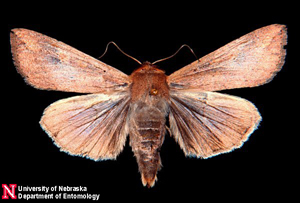
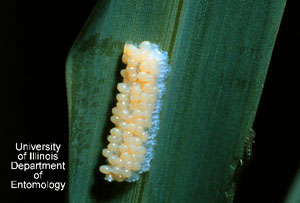
(L) Figure 1. Adult armyworm moth (R) Figure 2. Armyworm eggs
Moths lay eggs at night in folded leaves or under leaf sheaths of small-grain plants and other grasses. Armyworm eggs look like small white beads arranged in rows resembling miniature pearls (Figure 2). Larvae hatch from eggs in eight to 10 days.
Caterpillars usually feed at night and hide during the day, however, they have been seen on smooth brome stems during cloudy and overcast days this spring. The caterpillars often curl when encountered, and have a conspicuous light-colored "stripe" on their side (Figures 3, 4).Caterpillars will eat plant materials for three to four weeks. If all the food at a site is consumed, larvae often move in hordes or "armies," eating and destroying vegetation as they move.
When feeding is complete, larvae move under litter/thatch or burrow 2 to 3 inches into the soil, where they make small earthen cells and pupate. About two weeks later, moths emerge from pupal cases (Figure 3), mate and lay eggs for the next generation. Several generations occur annually in Nebraska.

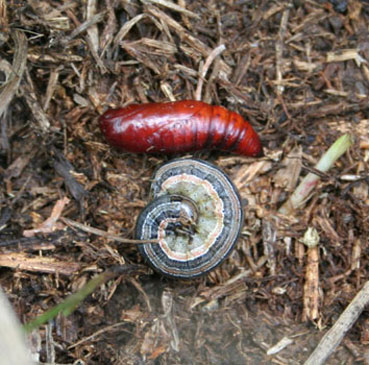
(L) Figure 3. Larval identification characteristics. (Illustration by Jim Kalisch) Figure 4. Curled armyworm caterpillar and pupa
Damage and Scouting
Feeding damage from armyworms on cool season grasses is usually noted before the caterpillars are found. Newly emerged caterpillars are small, and all stages of caterpillars can be difficult to find during the day as they feed at night. Caterpillars hide in or around the base of plants or in thatch during the day. Occasionally they will be found feeding during low light levels associated with overcast and cloudy conditions, and they have been sighted at dusk in panicles in areas with severe leaf defoliation. The best scouting technique is to look at leaves for feeding damage.
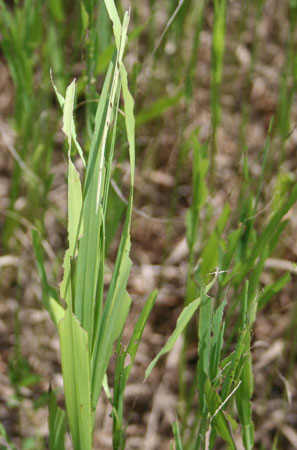
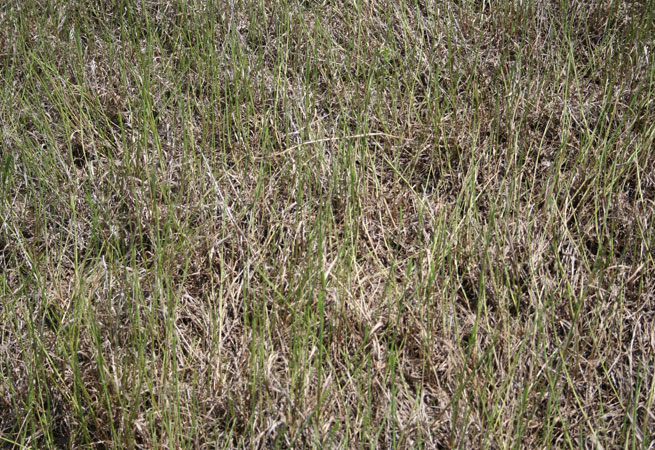
Figure 5. Leaf edge feeding on smooth by armyworm caterpillars. (R) Figure. 6. Severe armyworm feeding damage on smooth brome, Butler County, June 2015. Plants have been almost totally defoliated in spots and stems are being eaten.
Early feeding of young armyworms results in leaf material being scraped off in irregular patches, resulting in "window-panes" in the leaves. However, these can be difficult to find. A more reliable indicator is an irregular leaf edge resulting from feeding by larger caterpillars (Figure 5). Check the soil area in areas with irregular leaf edges for armyworm caterpillars.
When armyworms are larger and numerous, the entire leaf may be eaten and the entire plant can be defoliated (Figure 6). Also there have been instances where stems have been eaten from the top down toward the soil line.Economic/treatment thresholds have not been established for Nebraska smooth brome. In other states recommended treatments for forage grasses when 25% of the plants show feeding damage and there is an average of three or more armyworm caterpillars per square foot at the soil surface/thatch.
Detecting and controlling armyworms while they are small to medium in size ( less than 1 inch in length) and before they do extensive damage (Level 4 and above, see Table 1) is extremely important to limit economic damage. Very large caterpillars (1.25-1.5+ inches in length) can eat much more forage than smaller caterpillars and are also more difficult to control. Control may not be justified if all the caterpillars are very large, as they will soon cease feeding and pupate.
| Table 1. Stages 1-8 of armyworm feeding damage in smooth brome | ||
| Stage | Description/Feeding | Defoliation (Percentage) |
| 0 | Eggs laid | |
| 1 | Hatch and window paning | |
| 2 | Feeding noted on lower leaf edges | |
| 3 | Lower leaves being consumed | 20% |
| 4 | Feeding on lower and middle leaves | 40% |
| 5 | Feeding on middle and upper leaves, lower leaves consumed (4-5 nodes with leaf tissue present) | 60% |
| 6 | Feeding on upper plant leaves, other leaves consumed (2-3 leaves with foliage present) | 80% |
| 7 | All leaves eaten | 100% |
| 8 |
All leaves eaten, stems being eaten |
100% |
Insecticide Controls and Concerns About Cattle In Pastures
A number of insecticides are labeled for control of armyworms in grass pastures and hay fields, but producers are concerned about cattle and grazing/haying restrictions. Insecticide active ingredients labeled for grasses that have 0 day grazing restrictions and are expected to provide rapid and excellent control of armyworms include a few synthetic pyrethroid active ingredients, including:
- Lambda-cyhalothrin (Paradigm, Silencer, Warrior, and Warrior II)
- Zeta-cypermethrin (MustangMax),
- several products containing spinosad as an active ingredient (Blackhawk, Entrust SC and Seduce Insect Bait), and
- methoxyfenozide (Intrepid 2F).
Applicators are urged to check and follow labels for buffer zone requirements. While these products have 0 day grazing restrictions, cattle should not be over-sprayed with the insecticides when applied, and should not have contact with the treated areas until the sprays have dried.
There are also concerns about canopy penetration so that the insecticide reaches caterpillars. Heavy and tall forage growth is expected to result in crop intercept of the insecticide in the upper half of the crop canopy, and may not penetrate to the lower plant area where the armyworms spend the day. Several products are expected to provide more than seven days of activity. Applications at dusk/night may provide better control as caterpillars will be on plants and more likely to encounter direct application.Of the products listed there is one bait (Seduce Insecticide Bait). This product is expected to go beyond the crop canopy and reach the thatch/soil surface. Armyworm control efficacy data by this product in smooth brome is not readily available.
Michael RethwischExtension Educator
Online Master of Science in Agronomy
With a focus on industry applications and research, the online program is designed with maximum flexibility for today's working professionals.
